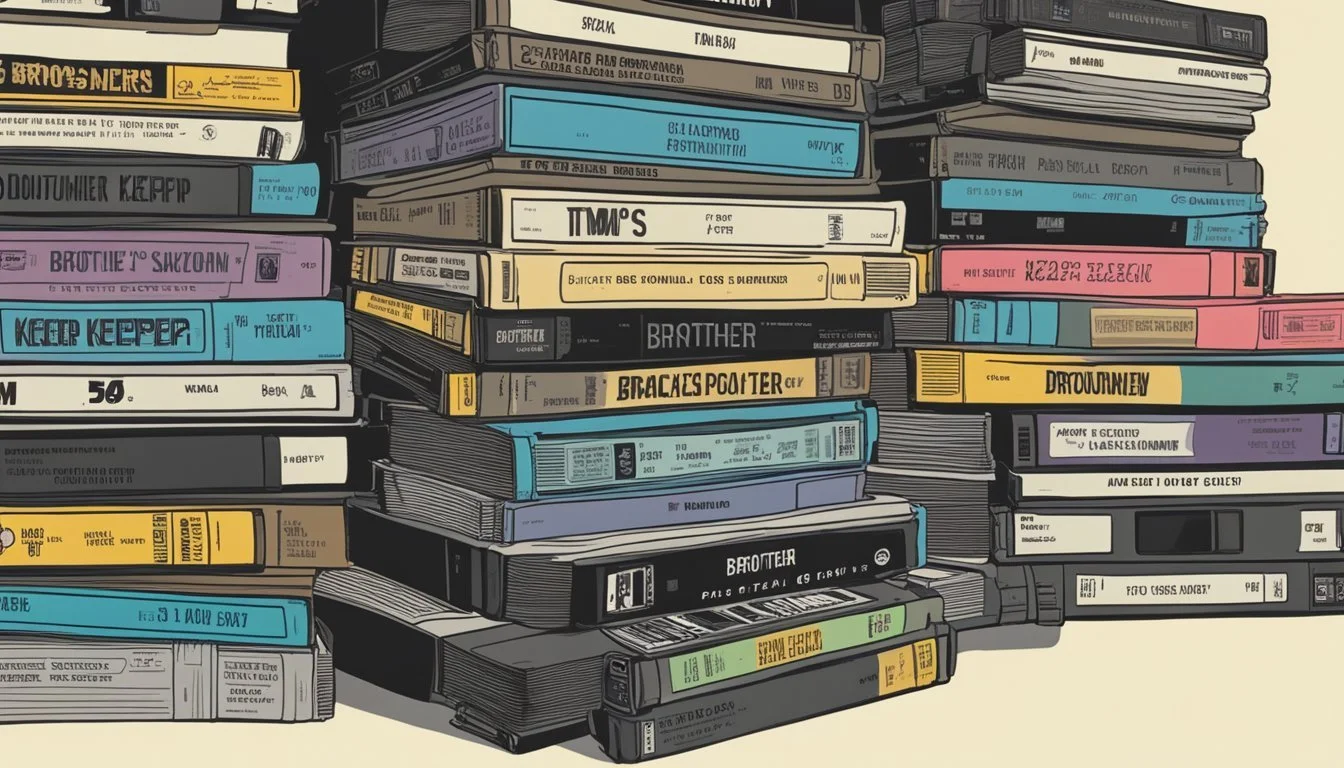Top Documentaries of 1992
Essential Viewing from a Landmark Year in Film
The year 1992 marked a significant period in documentary filmmaking. As cinema evolved and new storytelling techniques emerged, documentaries captured real-world events and social issues with increasing depth and nuance. This pivotal year saw the release of several groundbreaking non-fiction films that continue to resonate with audiences today.
Documentaries from 1992 offer valuable insights into the cultural, political, and social landscape of the early 1990s. These films cover a wide range of subjects, from intimate personal stories to large-scale global events. Through their unique perspectives and innovative approaches, the top documentaries of 1992 helped shape the genre and paved the way for future documentary filmmakers.
1) A Brief History of Time (1991)
A Brief History of Time is a documentary film directed by Errol Morris about the renowned physicist Stephen Hawking. The film explores Hawking's life and groundbreaking work in cosmology.
Morris interweaves interviews with Hawking's family members and colleagues with explanations of complex scientific concepts. The documentary showcases Hawking's brilliance and determination in the face of his motor neuron disease.
The film adapts Hawking's bestselling book of the same name, which explains theories about the universe's origins. It balances biographical elements with accessible explanations of Hawking's research on black holes and the nature of time.
A Brief History of Time received critical acclaim for its engaging portrayal of Hawking and ability to convey complex ideas to a general audience. It won several awards, including the Grand Jury Prize at the Sundance Film Festival.
More information on A Brief History of Time
2) Brother's Keeper
Brother's Keeper (1992) is a critically acclaimed documentary directed by Joe Berlinger and Bruce Sinofsky. The film explores a murder case in rural Munnsville, New York.
At its core, the documentary focuses on the Ward brothers, four elderly and uneducated farmers living in isolation. When one brother dies under mysterious circumstances, another is accused of murder.
The film skillfully examines the complexities of small-town life and the criminal justice system. It raises questions about mercy killing, family bonds, and the treatment of outsiders in tight-knit communities.
Brother's Keeper received numerous accolades, including the Audience Award at the Sundance Film Festival. Critics praised its unbiased approach and compelling storytelling.
The documentary's success helped establish Berlinger and Sinofsky as prominent figures in the genre. It remains a landmark film in the world of documentary cinema.
More information on Brother's Keeper
3) The Panama Deception (1992)
"The Panama Deception" is a documentary film directed by Barbara Trent that won the Academy Award for Best Documentary Feature in 1992. The film provides a critical examination of the 1989 United States invasion of Panama, known as Operation Just Cause.
Narrated by actress Elizabeth Montgomery, the documentary contrasts media coverage of the invasion with its own investigative findings. It explores the underlying reasons for the U.S. military intervention and its consequences for Panamanian civilians.
The film argues that the official justifications for the invasion were misleading. It suggests that the true motives were more complex than publicly stated, involving factors such as control of the Panama Canal and U.S. strategic interests in the region.
"The Panama Deception" features interviews with various individuals, including Panamanians affected by the conflict. It also incorporates archival footage to support its claims about the nature and impact of the invasion.
The documentary sparked discussions about U.S. foreign policy and media coverage of military interventions. It remains a notable work in the genre of political documentaries.
4) Candyman
Candyman (1992) is a supernatural horror film directed by Bernard Rose. Based on Clive Barker's short story "The Forbidden", the movie explores urban legends and racial tensions in Chicago.
Virginia Madsen stars as Helen Lyle, a graduate student researching urban myths. Her investigation leads her to the legend of Candyman, a vengeful spirit with a hook for a hand.
Tony Todd delivers a chilling performance as the titular Candyman. His deep voice and imposing presence create a memorable horror villain. The film's exploration of racial history and gentrification adds depth to the scares.
Candyman features striking visuals and a haunting score by Philip Glass. Its blend of psychological horror and social commentary sets it apart from other 1990s horror films.
The movie spawned several sequels and a 2021 remake, cementing its place in horror film history. Candyman remains influential for its unique take on urban legends and racial themes in the horror genre.
More information on Candyman (1992)
5) Baraka
Baraka (1992) stands as a groundbreaking non-narrative documentary directed by Ron Fricke. The film takes viewers on a visual journey across 24 countries on six continents, capturing the diversity of human cultures and their relationship with the environment.
Shot in stunning 70mm Todd-AO format, Baraka showcases breathtaking imagery from locations like Tanzania, China, Brazil, Japan, Nepal, and various European countries. The film's title comes from a Sufi word meaning "blessing" or "the essence of life."
Fricke, who previously worked as cinematographer on Koyaanisqatsi, employs time-lapse photography and slow motion to create a mesmerizing visual experience. The absence of dialogue or narration allows the powerful imagery to speak for itself.
Baraka explores themes of spirituality, nature, and human impact on the world. It juxtaposes scenes of pristine natural beauty with industrial landscapes and urban environments, prompting reflection on humanity's place in the global ecosystem.
The film's innovative approach to documentary filmmaking and its universal themes have earned it critical acclaim and a lasting place in cinema history.
More information on Baraka (1992)
6) Manufacturing Consent: Noam Chomsky and the Media (1992)
This documentary explores the political ideas of renowned linguist and activist Noam Chomsky. Directed by Mark Achbar and Peter Wintonick, it expands on Chomsky's book of the same name.
The film examines Chomsky's critique of corporate media and its role in shaping public opinion. It argues that profit-driven media outlets often serve elite interests rather than providing unbiased information.
Through interviews and archival footage, the documentary presents Chomsky's views on propaganda, consent manufacturing, and media manipulation. It highlights how these processes can influence democratic societies.
The filmmakers use creative visual techniques to illustrate complex concepts. This approach helps make Chomsky's ideas accessible to a wider audience beyond academic circles.
"Manufacturing Consent" received critical acclaim for its thought-provoking content and innovative presentation. It remains a significant work in media studies and political documentary filmmaking.
7) Incident at Oglala (1992)
Incident at Oglala is a compelling documentary directed by Michael Apted and narrated by Robert Redford. The film examines the controversial events surrounding a 1975 shootout on the Pine Ridge Indian Reservation in South Dakota.
The documentary focuses on the deaths of two FBI agents and a Native American man during the incident. It explores the subsequent investigation and legal proceedings, particularly the case against Leonard Peltier, a member of the American Indian Movement.
Apted's film presents a balanced view of the complex situation, incorporating interviews with key figures and archival footage. It raises questions about the justice system and the treatment of Native Americans.
Critics praised Incident at Oglala for its thoughtful approach and its ability to shed light on an often-overlooked chapter of American history. The documentary's even-handed presentation allows viewers to form their own opinions about the case.
Incident at Oglala stands as an important work that highlights issues of social justice and indigenous rights in the United States.
8) Reversing Roe (2018)
Reversing Roe examines the history and politics of abortion rights in the United States. Directed by Ricki Stern and Annie Sundberg, this documentary provides an in-depth look at the landmark Roe v. Wade case and its ongoing impact.
The film features interviews with key figures on both sides of the abortion debate. It explores how the issue became deeply politicized over time. Reversing Roe traces legal developments and shifting public attitudes around abortion access.
Stern and Sundberg present archival footage and expert commentary to contextualize the complex topic. The documentary highlights pivotal moments that shaped abortion policy in America.
Reversing Roe offers a balanced perspective on this contentious issue. It avoids taking an explicit stance while illuminating the arguments of pro-choice and pro-life advocates.
The film provides valuable historical background on reproductive rights in the U.S. It serves as a timely examination of a subject that continues to divide public opinion.
More information on Reversing Roe
9) Visions of Light: The Art of Cinematography (1992)
"Visions of Light: The Art of Cinematography" explores the craft and artistry behind cinematography in film. Directed by Arnold Glassman, Todd McCarthy, and Stuart Samuels, this documentary features interviews with renowned cinematographers.
The film showcases clips from over 100 movies, spanning from early silent films to modern classics. It highlights how cinematography has evolved and shaped visual storytelling in cinema.
Viewers gain insights into the technical and creative aspects of lighting, framing, and camera movement. Cinematographers discuss their collaborations with directors and their approaches to creating memorable visual compositions.
"Visions of Light" emphasizes the crucial role cinematographers play in bringing a director's vision to life. It demonstrates how lighting and camera techniques can establish mood, enhance performances, and convey narrative themes.
The documentary received critical acclaim for its in-depth examination of an often overlooked aspect of filmmaking. It serves as both an educational resource for aspiring filmmakers and an appreciation of cinematic artistry for general audiences.
10) Lessons of Darkness
Werner Herzog's "Lessons of Darkness" (1992) is a haunting documentary that explores the aftermath of the Gulf War in Kuwait. The film showcases the devastated oil fields, presenting a surreal and apocalyptic landscape.
Herzog's distinctive approach combines striking visuals with minimal narration. He captures burning oil wells and vast stretches of scorched earth, creating an almost otherworldly atmosphere.
The documentary eschews traditional storytelling, instead relying on powerful imagery and music to convey its message. Herzog's camera work transforms the destruction into a mesmerizing spectacle.
"Lessons of Darkness" blurs the line between documentary and art film. It offers a unique perspective on war's environmental impact, inviting viewers to contemplate the consequences of human conflict.
The film's unconventional style and thought-provoking content have earned it a place among notable documentaries of 1992. It continues to be studied and discussed for its artistic merits and philosophical implications.
More information on Lessons of Darkness
Cultural Significance of 1992 Documentaries
Documentaries from 1992 left a lasting impact on society and filmmaking. They explored important social issues and introduced innovative techniques that influenced future documentary creators.
Impact on Society
1992 documentaries shed light on pressing social topics. Films like "Aileen Wuornos: The Selling of a Serial Killer" examined complex criminal cases, sparking public discourse on justice and media portrayal. Environmental documentaries raised awareness about ecological concerns, inspiring conservation efforts.
Some films tackled political subjects, offering behind-the-scenes glimpses into campaigns and governmental processes. This transparency helped viewers better understand the inner workings of politics and power structures.
Cultural documentaries celebrated diversity and highlighted underrepresented communities. These films fostered greater empathy and cross-cultural understanding among audiences.
Influence on Filmmaking
The documentaries of 1992 pushed creative boundaries and introduced new storytelling techniques. Filmmakers experimented with narrative structures, blending observational footage with stylized recreations.
Advancements in portable video technology allowed for more intimate and spontaneous filming. This resulted in a more authentic, immediate style that became influential in later documentaries.
Some 1992 documentaries utilized innovative visual techniques. "Baraka", for example, employed stunning time-lapse photography and wordless storytelling to create a powerful sensory experience.
These films also expanded the definition of documentary, incorporating elements of personal essay and experimental cinema. This broadened approach inspired future filmmakers to explore new forms of non-fiction storytelling.
Notable Filmmakers of 1992
1992 saw several filmmakers make significant contributions to cinema. Directors and producers pushed boundaries and created lasting works that continue to influence the industry.
Influential Directors
Quentin Tarantino burst onto the scene with "Reservoir Dogs," introducing his signature style of nonlinear storytelling and pop culture-infused dialogue. The film's impact on independent cinema was immediate and enduring.
Clint Eastwood directed and starred in "Unforgiven," a revisionist Western that earned him Academy Awards for Best Director and Best Picture. The film showcased Eastwood's evolution as a filmmaker and his ability to subvert genre expectations.
Robert Zemeckis helmed "Death Becomes Her," a dark comedy that showcased groundbreaking visual effects. The film's innovative use of CGI paved the way for future advancements in digital filmmaking.
Pioneering Producers
Don Simpson and Jerry Bruckheimer continued their streak of high-concept blockbusters with "The Bodyguard," starring Whitney Houston and Kevin Costner. The film's soundtrack became one of the best-selling of all time.
David Geffen, Jeffrey Katzenberg, and Thomas Schumacher produced Disney's "Aladdin," which became a massive commercial and critical success. The film's innovative animation techniques and Robin Williams' performance as the Genie set new standards for animated features.
Arnon Milchan produced "JFK" and "The Mambo Kings," demonstrating his ability to balance controversial political dramas with music-driven period pieces. Milchan's diverse portfolio solidified his reputation as a versatile and risk-taking producer.




